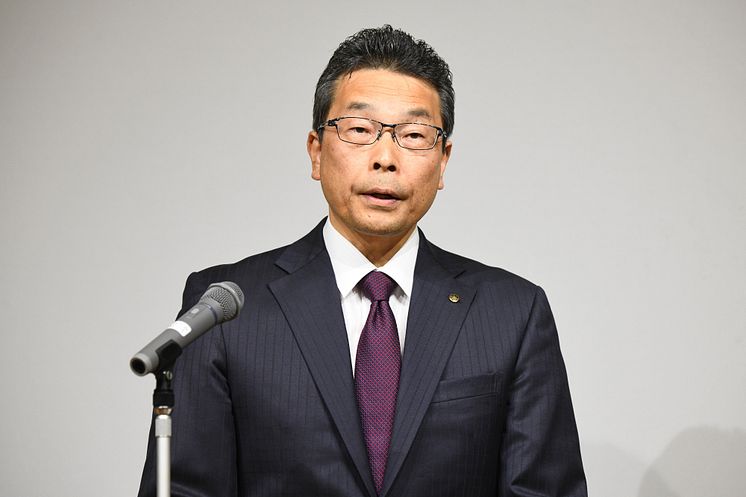Press release -
Consolidated Business Results Summary - Fiscal Year Ending December 31, 2020 -
■ Consolidated Business Results
IWATA, February 12, 2021 - Yamaha Motor Co., Ltd. (Tokyo: 7272) announces its consolidated business results for the full fiscal year. Net sales for Yamaha Motor Co., Ltd.’s consolidated accounting period were 1,471.3 billion yen (a decrease of 193.5 billion yen or 11.6% compared with the previous fiscal year). Operating income was 81.7 billion yen (a decrease of 33.7 billion yen or 29.2%), ordinary income was 87.7 billion yen (a decrease of 31.8 billion yen or 26.6%), and net income for the period attributable to owners of parent was 53.1 billion yen (a decrease of 22.7 billion yen or 29.9%). We were able to somewhat recover from the adverse effects brought by the COVID-19 pandemic in the first half of the year thanks to our results in the fourth quarter (October–December), with net sales of 404.2 billion yen (an increase of 6.7 billion yen or 1.7% compared with the same period of the previous fiscal year) and an operating income of 25.3 billion yen (an increase of 9.9 billion yen or 64.5%). For the full fiscal year, the U.S. dollar was traded at 107 yen (an appreciation of 2 yen from the previous fiscal year) and the euro at 122 yen (no change).
For net sales, although sales increased in the Robotics and Financial Services businesses, the impact of the COVID-19 pandemic saw a decrease in unit sales of motorcycles in the Land Mobility business as well as in the Marine Products, resulting in a decline in sales overall. Operating income declined overall due to factors such as lower sales, the impact of foreign exchange rates and decreases in utilization rates from the factory closures enacted in various countries in the first half of the year.
■ Results by Business Segment
Land Mobility Business
Net sales were 946.5 billion yen (a decrease of 173.4 billion yen or 15.5% compared with the previous fiscal year) and operating income was 18.5 billion yen (a decrease of 23.2 billion yen or 55.7%).
For motorcycles in developed markets, immediate total demand has recovered, but production was unable to keep up with the rapid pace of recovery and unit sales fell. In addition, temporary closures of factories in Japan and France lowered utilization rates, which in turn led to decreased sales and profits.
For motorcycles in emerging markets, total demand is generally trending toward recovery, but the lockdowns and restrictions on social activities due to COVID-19 has led to an economic slowdown, declining consumer sentiment and other effects, and this resulted in lower sales and profits overall. In Indonesia, stricter scrutiny of sales financing due to the economic downturn and large-scale social restrictions continued, sharply dropping demand. In the Philippines, the recovery in immediate total demand was swift but supply was unable to keep pace and unit sales declined. In Vietnam, total demand is recovering steadily, but the economic recession has brought increased sales of low-price models, which has harmed the model mix. On the other hand, in India, immediate total demand has recovered and sales of new models have been strong, with results from August onward exceeding those of the previous year. In Taiwan, the government’s subsidy programs for gas-powered models were a tailwind, and total demand as well as wholesales have recovered to levels exceeding last year.
With recreational vehicles (all-terrain vehicles, ROVs and snowmobiles), a spike in demand for outdoor recreation products led to greater sales in our principal markets—including the biggest market of North America—and sales and profits both grew.
For electrically power-assisted bicycles, the impacts of the COVID-19 pandemic in Japan brought about production delays and the ceasing of sales work, resulting in lower complete bicycle unit sales and thus lower sales numbers. However, an increase in sales of e-Bike system kits improved the model mix, bringing in higher profits.
Marine Products Business
Net sales were 328.3 billion yen (a decrease of 21.7 billion yen or 6.2% compared with the previous fiscal year) and operating income was 50.6 billion yen (a decrease of 7.7 billion yen or 13.3%).
The effects of COVID-19 were felt in the first half of the year, but the surge in demand for products for outdoor recreation following the easing of lockdowns grew demand for outboard motors and personal watercraft. Unit sales of marine products overall declined due to the temporary closures of boatbuilders and dealerships in North America as well as temporary factory closures in Japan and in the U.S. However, unit sales of outboard motors for North America and Europe in the second half of the year grew thanks to raising production capacity utilization rates upon reopening the factories. Sales of large outboard models continue to grow even amid the COVID-19 pandemic, but we were unable to mitigate the effects from the first half of the year and the business overall recorded lower sales and profits.
Robotics Business
Net sales were 83.0 billion yen (an increase of 7.4 billion yen or 9.7% compared with the previous fiscal year) and operating income was 3.3 billion yen (a decrease of 4.4 billion yen or 57.4%).
Unit sales of surface mounters in Asia (including China, Taiwan and South Korea) grew throughout the year, and sales in Europe and the United States also recovered during the second half of the year, but the curbing of investments in the automobile sector in Japan and other countries saw the model mix suffer as a result. Additionally, the effects of creating Yamaha Robotics Holdings Co., Ltd. (name changed on January 1, 2021) as a new subsidiary at the end of the second quarter in 2019 led to higher sales but lower profits.
Financial Services Business
Net sales were 46.1 billion yen (an increase of 5.1 billion yen or 12.5% compared with the previous fiscal year) and operating income was 7.6 billion yen (a decrease of 0.5 billion yen or 5.9%).
The business’ performance in developed markets was strong and led to higher sales, but the effect of exchange rates, an increase in the allowance for doubtful accounts and a decrease in receivables from wholesale sales resulted in lower profits.
Other Products Business
Net sales were 67.4 billion yen (a decrease of 10.9 billion yen or 13.9% compared with the previous fiscal year) and operating income was 1.7 billion yen (compared to an operating loss of 0.4 billion yen the previous fiscal year).
Unit sales of golf cars and generators decreased, leading to a decrease in sales. Operating income increased year-on-year due to costs incurred from market countermeasures implemented the previous year.
■ Forecast of Consolidated Business Results for the Fiscal Year Ending December 31, 2021
With the spread of COVID-19 restricting outings and travel in numerous countries, 2020 was a year that brought consumption and corporate economic activity to a standstill. Things will remain unpredictable in 2021, but it is expected to be a year in which the world will gradually begin returning to pre-COVID life as vaccine development and deployment proceeds. In and amongst this environment, we expect high production utilization rates in the first half of this year in the Land Mobility and Marine Products businesses in order to help replenish product inventories for developed markets. In the Robotics business, we expect demand in developed markets to recover in addition to greater demand for our products in China. The recovery of demand for motorcycles in emerging markets is expected to steadily progress. However, we also expect soaring transport costs from a global shortage of shipping containers and impacts to part procurement due to a shortage of semiconductors. Still, even in this business environment, we will implement new ways of working and utilize digital technology for our advertising and events to carry on our efforts to reduce expenses. Based on this, the consolidated financial forecast for fiscal 2021 are as follows:

These forecast figures are based on the U.S. dollar trading at 103 yen (an appreciation of 4 yen from the previous fiscal year) and the euro at 126 yen (a depreciation of 4 yen).
■ Basic Policy for Profit Distribution and Dividends for the Current and Following Fiscal Years
Yamaha Motor considers enhancing the interests of shareholders an important management issue and endeavors to raise its corporate value. With regard to dividend payments, we seek to strike a balance between investments for new growth and returns to shareholders within the range of our cash flow while maintaining the earnings power of our existing businesses. We have set a benchmark of 30% for the dividend payout ratio of net income attributable to owners of parent and will work to provide consistent and sustainable payments.
Yamaha has a basic policy of paying an interim dividend and a year-end dividend. The decision-making bodies for dividends are the Board of Directors for interim dividends and the Ordinary General Meeting of Shareholders for year-end dividends. In addition, the company’s Articles of Incorporation provide that the record date for the interim dividend shall be June 30 and December 31 for the year-end dividend.
Regarding the dividend for fiscal 2020, a dividend of 60 yen per share is planned to be placed on the agenda for the 86th Ordinary General Meeting of Shareholders scheduled for March 24, 2021. For the dividend payment for fiscal 2021, a total of 90 yen (interim dividend of 45 yen and year-end dividend of 45 yen) is planned.





Topics
Categories
*This is a dedicated e-mail providing Yamaha Motor PR materials for viewing by media journalists.
We request that you refrain from using the materials and photographs on this e-mail for purposes other than media reporting.


